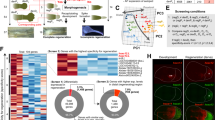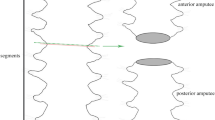Abstract
Limb autotomy and regeneration are specific adaptations of crustaceans in response to external stress and attacks, which make them a suitable model to investigate the mechanism of organ regeneration in invertebrates. In this study, the Hippo gene of Eriocheir sinensis (EsHPO) was identified, and the effects of Hippo signaling on limb regeneration were evaluated. The expression of EsHPO and other key components of Hippo signaling was down-regulated during the basal growth phase in response to limb autotomy stress and then up-regulated during the proecdysial growth phase. The descending expression patterns of Hippo signal components were correlated with transcriptional activation of YKI and downstream target genes during the blastema formation stage, which suggested that Hippo signaling plays a key role during limb regeneration in E. sinensis. To further test the hypothesis, the transcription factor YKI was blocked via verteporfin injection after autotomy, which disrupted limb regeneration by repressing wound healing and preventing blastema emergence. Furthermore, our experiments revealed that the proliferation of blastema cells was blocked by verteporfin. In addition, the expression of genes related to ECM remodeling, cell cycle progression, and apoptosis resistance was down-regulated following the injection of verteporfin. Our findings therefore indicate that Hippo signaling is essential for successful wound healing and limb regeneration in E. sinensis by inducing ECM remodeling, as well as promoting the proliferation and repressing the apoptosis of blastema cells.






Similar content being viewed by others
Data Availability
All data generated and analyzed in this study are available within the article and the supplementary information.
References
Ahmad V, Vadla GP, Chabu CY (2021) Syd/JIP3 controls tissue size by regulating Diap1 protein turnover downstream of Yorkie/YAP. Dev Biol 469:37–45
Brewer CM, Nelson BR, Wakenight P et al (2021) Adaptations in Hippo-Yap signaling and myofibroblast fate underlie scar-free ear appendage wound healing in spiny mice. Dev Cell 56:2722-2740.e6
Cui Z, Liu Y, Yuan J et al (2021) The Chinese mitten crab genome provides insights into adaptive plasticity and developmental regulation. Nat Commun 12:2395
Das S (2015) Morphological, molecular, and hormonal basis of limb regeneration across pancrustacea. Integr Comp Biol 55(5):869-77
Dey A, Varelas X, Guan K-L (2020) Targeting the Hippo pathway in cancer, fibrosis, wound healing and regenerative medicine. Nat Rev Drug Discov 19:480–494
Emberts Z, Escalante I, Bateman PW (2019) The ecology and evolution of autotomy. Biol Rev 94:1881–1896
Fu Y, Liu L, Wang C et al (2019) Suppression of limb regeneration by RNA interference of WNT4 in the swimming crab Portunus trituberculatus. Comp Biochem Physiol B Biochem Mol Biol 234:41-49
Gehrke AR, Neverett E, Luo Y-J et al (2019) Acoel genome reveals the regulatory landscape of whole-body regeneration. Science 363(6432):eaau6173
Gong J, Huang C, Yu K et al (2022) The effects of feeding ration and cheliped autotomy on the growth and expression of ecdysteroid receptor in early juvenile mud crabs. Scylla Paramamosain Aquac Rep 25:101206
Hayashi S, Ochi H, Ogino H et al (2014a) Transcriptional regulators in the Hippo signaling pathway control organ growth in Xenopus tadpole tail regeneration. Dev Biol 396:31–41
Hayashi S, Tamura K, Yokoyama H (2014b) Yap1, transcription regulator in the Hippo signaling pathway, is required for Xenopus limb bud regeneration. Dev Biol 388:57–67
He J, Wu X, Cheng Y (2016) Effects of limb autotomy on growth, feeding and regeneration in the juvenile Eriocheir sinensis. Aquaculture 457:79–84
Hopkins PM (2001) Limb regeneration in the fiddler Crab, Uca pugilator : hormonal and growth factor control. Am Zool 41:389–398
Huang J, Wu S, Barrera J et al (2005) The Hippo signaling pathway coordinately regulates cell proliferation and apoptosis by inactivating Yorkie, the drosophila homolog of YAP. Cell 122:421–434
Huang Y, Ma F, Ren Q (2020) Function of the MOB kinase activator-like 1 in the innate immune defense of the oriental river prawn (Macrobrachium nipponense). Fish Shellfish Immunol 102:440–448
Huang Y, Ren Q (2021) A newly identified Hippo homologue from the oriental river prawn Macrobrachium nipponense is involved in the antimicrobial immune response. Vet Res 52:76
Jacyniak K, McDonald RP, Vickaryous MK (2017) Tail regeneration and other phenomena of wound healing and tissue restoration in lizards. J Exp Biol 220:2858–2869
Konishi T, Schuster RM, Lentsch AB (2018) Proliferation of hepatic stellate cells, mediated by YAP and TAZ, contributes to liver repair and regeneration after liver ischemia-reperfusion injury. Am J Physiol Gastrointest Liver Physiol 314:G471–G482
Li J, Tian Y, Li X et al (2022) Insulin-like signaling promotes limb regeneration in the Chinese mitten crab (Eriocheir sinensis). Fish Shellfish Immunol 122:268–275
Lin AYT, Pearson BJ (2014) Planarian Yorkie/YAP functions to integrate adult stem cell proliferation, organ homeostasis and maintenance of axial patterning. Development 141:1197–1208
Liu L, Fu Y, Zhu F et al (2018) Transcriptomic analysis of Portunus trituberculatus reveals a critical role for WNT4 and WNT signalling in limb regeneration. Gene 658:113–122
Mascharak S, desJardins-Park HE, Davitt MF et al (2021) Preventing Engrailed-1 activation in fibroblasts yields wound regeneration without scarring. Science (1979) 372(6540):eaba2374
Mateus R, Lourenço R, Fang Y et al (2015) Control of tissue growth by Yap relies on cell density and F-actin in zebrafish fin regeneration. Development 142(16):2752-63
Misra JR, Irvine KD (2018) The Hippo signaling network and its biological functions. Annu Rev Genet 52:65–87
Moya IM, Halder G (2019) Hippo–YAP/TAZ signalling in organ regeneration and regenerative medicine. Nat Rev Mol Cell Biol 20:211–226
Mugahid D, Kalocsay M, Liu X et al (2020) YAP regulates cell size and growth dynamics via non-cell autonomous mediators. Elife 9:e53404
Oliveira DN de, Christofoletti RA, Barreto RE (2015) Feeding behavior of a Crab according to cheliped number. PLoS One 10(12):e0145121
Phillips JE, Santos M, Konchwala M et al (2022) Genome editing in the unicellular holozoan Capsaspora owczarzaki suggests a premetazoan role for the Hippo pathway in multicellular morphogenesis. Elife 11:e77598
Shinji J, Gotoh H, Miyanishi H et al (2019) The activin signaling transcription factor Smox is an essential regulator of appendage size during regeneration after autotomy in the crayfish. Evol Dev 21:44–55
Shi-Wen X, Leask A, Abraham D (2008) Regulation and function of connective tissue growth factor/CCN2 in tissue repair, scarring and fibrosis. Cytokine Growth Factor Rev 19:133–144
Wang J, Chen X, Hou X et al (2022) “Omics” data unveil early molecular response underlying limb regeneration in the Chinese mitten crab, Eriocheir sinensis. Sci Adv 8(37):eabl4642
Wehner D, Weidinger G (2015) Signaling networks organizing regenerative growth of the zebrafish fin. Trends Genet 31(6):336–343
Yang L, Li X, Qin X et al (2019) Deleted in azoospermia-associated protein 2 regulates innate immunity by stimulating Hippo signaling in crab. J Biol Chem 294:14704–14716
Funding
This work was supported by the National Natural Science Foundation of China [81903776], the National Key R&D Program of China [2018YFD0901301], and the Training Programs of Innovation and Entrepreneurship for Undergraduates [202110065136].
Author information
Authors and Affiliations
Contributions
YW and XH performed the experiments and prepared all figures. QZ, YT, and JZ participated in inhibitor injection and qRT-PCR analysis. ZY and YL supervised the study and edited the manuscript. JL generated the hypothesis, designed the experiments, and wrote and edited the manuscript. JS supervised the study and provided funding. All authors reviewed and approved the final manuscript.
Corresponding authors
Ethics declarations
Ethical Approval
All animal protocols were approved by the Ethics Committee of Tianjin Normal University (Registration number: SD2020009).
Conflict of Interest
The authors declare no competing interests.
Additional information
Publisher's note
Springer Nature remains neutral with regard to jurisdictional claims in published maps and institutional affiliations.
Supplementary Information
Below is the link to the electronic supplementary material.
Rights and permissions
Springer Nature or its licensor (e.g. a society or other partner) holds exclusive rights to this article under a publishing agreement with the author(s) or other rightsholder(s); author self-archiving of the accepted manuscript version of this article is solely governed by the terms of such publishing agreement and applicable law.
About this article
Cite this article
Wang, Y., Huang, X., Zhou, Q. et al. Hippo Signaling Regulates Blastema Formation During Limb Regeneration in Chinese Mitten Crab (Eriocheir sinensis). Mar Biotechnol 25, 204–213 (2023). https://doi.org/10.1007/s10126-022-10194-0
Received:
Accepted:
Published:
Issue Date:
DOI: https://doi.org/10.1007/s10126-022-10194-0




